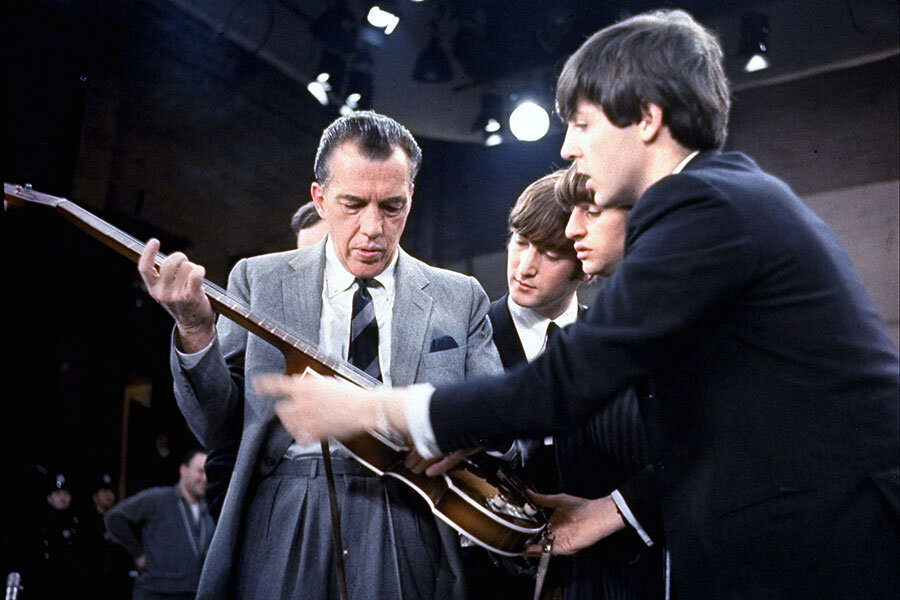The Beatles: 50 years after 'Ed Sullivan,' they're everywhere, in everything
Loading...
“I had never screamed for music before,” says songwriter Bonnie Hayes, sounding still slightly shocked at her own behavior.
She was in the third grade the first time she saw The Beatles. Like 73 million Americans, she and her father were watching "The Ed Sullivan Show" when the mop-top crew of rockers in suits belted out “All My Loving” to hundreds of shrieking teen girls.
“It was like nothing we’d ever seen before,” Ms. Hayes says. “There was something about that long hair with those shaking heads that just brought this scream from somewhere deep inside me.”
That was Feb. 9, 1964. The Fab Four had already earned a place on the music charts in Britain, but many in America had never heard anything like the Beatles. Rock 'n' roll had seemingly come and gone with the death of Buddy Holly in a plane crash in 1959 and Elvis's transition from stage performer to actor in 1961. With that iconic performance, "those four screaming, strumming, young Liverpudlians ... known as the Beatles" swept much of the nation off its feet, John Hughes reported in a front page story in The Monitor two days later.
Fifty years later, the Beatles' influence lives on in nearly every song on today’s popular music charts.
Solo crooner Bruno Mars, boy band One Direction, indie rock band Cornershop, and power pop band Fountains of Wayne all have echoes of the Beatles in their current work, says Rachel Rubin, a professor of American popular culture at the University of Massachusetts in Boston. Even hip hop owes a nod to the Beatles, who were the first musicians to use recorded samples of nonmusical sounds in their recordings.
The Beatles created their own “musical vocabulary,” that has become so much a part of music today that “any melody-driven pop group act will have been indirectly influenced, if not directly,” Professor Rubin says.
Over the years, bands like The Beach Boys and The Who modeled themselves after the Beatles. The Rolling Stones created the entire album "Let it Bleed" in response to the Beatles’ "Let it Be." Countless more musicians, including Joe Cocker, Ray Charles, Frank Sinatra, and David Bowie have covered Beatles songs.
“The Beatles were one of the most profound influences on songwriting – ever,” says Bonnie Hayes, professor and chair of the Songwriting Department at Berklee College of Music in Boston.
Professor Hayes has written songs for Bonnie Raitt, Bette Midler, Adam Ant, Cher, and Robert Cray, and credits much of her success to The Beatles.
“I took their songs apart with a microscope and tweezers and learned how they did it,” she says.
Today she urges her students at Berklee to do the same, pointing out the skill with which the band was able to weave together John Lennon’s “shuffley version of bluesy folk,” with Paul McCartney’s “American songbook style harmony.”
Just the fact that they wrote all of their own songs was groundbreaking for the time, but their ability to weave together a range of musical influences that spanned the globe was genre-shattering.
What’s more, they continued to break musical boundaries throughout their more than seven-year-long recording career.
“That was one of the weird things about the Beatles,” says Hayes. “Usually when bands hit a formula that worked they rode it till the end. Not the Beatles.”
Even more remarkably, they did it all with little to no classical training, says Stephen Schultz, a Carnegie Mellon music history professor who teaches a course on the music of the Beatles.
None of them could read or write music. McCartney had learned to play the piano as a boy, but beyond that, their musical acumen came from a genuine love of music and an uncanny ability to learn by ear, Professor Schulz says.
“They listened to a lot of music,” Schultz says. “Paul McCartney listened to a lot of classical music and brought that influence, John Lennon listened to a lot of rock 'n' roll, and George Harrison listened to a lot of Indian music and brought that influence.”
If they heard a new chord that they didn’t know how to play, they would take a bus across town, buy another guitarist a beer, and ask him to teach them to play it, says Chad Martin, an assistant professor of history and political science at the University of Indianapolis.
Perhaps it was that lack of formal training that made it possible for them to see over the typical genre boundaries. They managed to incorporate the sitar, musical scales borrowed from medieval church music, and “extramusical” sounds, such as seagulls or wine glasses all under the umbrella of pop music.
Until the Beatles came along, pop music was considered disposable, Professor Martin says.
“Pop was the music that people listened to as teenagers then dropped when they grew up, settled down, and developed taste,” Martin says. “The Beatles changed all that.”
While the most prominent Beatles fans at the time were the gaggles of shrieking, fainting teenyboppers, the band quickly earned recognition as serious musicians from many prominent musicians at the time, including renowned composer Leonard Bernstein.
Today, they are considered one of the greatest bands of all time, if not the greatest.
“You literally could teach a whole class, teaching everything that we teach at Berklee using just Beatles songs,” says Hayes.








